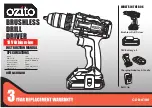
2.2 Wiring
INSTALLATION AND WIRING
13
2.2 Wiring
2.2.1 Terminal connection diagram (when source logic is selected)
"
"
"
"
3-phase 400V power input
3-phase AC
power supply
NFB
L
1
L
2
L
3
PC
24VDC power output and
contact input common
STF
STR
RH
RM
RL
MRS
RES
SD
Forward rotation start
Middle
High
Low
Output stop
Reset
Frequency setting signals (analog)
10(+5V)
2
2
3
1
4 to )
4(4 to 20mADC)
1/2W1k
Ω
RUN
FU
SE
Running
Frequency detection
AM
5
Control input signals
(no voltage input allowed)
Jumper
Remove this jumper when
using the optional power-factor
improving DC reactor.
Brake resistor connection
Motor
IM
Earth(Ground)
Alarm
output
A
B
C
U
V
W
P1
+
PR
−
Main circuit terminal
Control circuit input terminal
Control circuit output terminal
Earth(Ground)
0 to 5VDC
0 to 10VDC
Selected
Multi-speed selection
Open
collector outputs
Analog signal output
(0 to 10VDC)
External transistor common and
24VDC power output common
5(Analog common)
Open collector
output common)
(Note 1)
Frequency
setting
potentiometer
Current input(
−
)
PU connector
(RS-485)
Reverse rotation start
Note 3
Note 3
Note 4
Note 2
Note 2
MC
(+)
(
−
)
Note: 1. If the potentiometer is to be operated often, use a 2W1k
Ω
potentiometer.
2. Terminals 5, SD and SE are isolated.
3. Terminals SD and 5 are common terminals. Do not earth them to the
ground.
4. When terminals PC-SD are used as a 24VDC power supply, be careful not
to short these terminals. If they are shorted, the inverter will be damaged.
















































